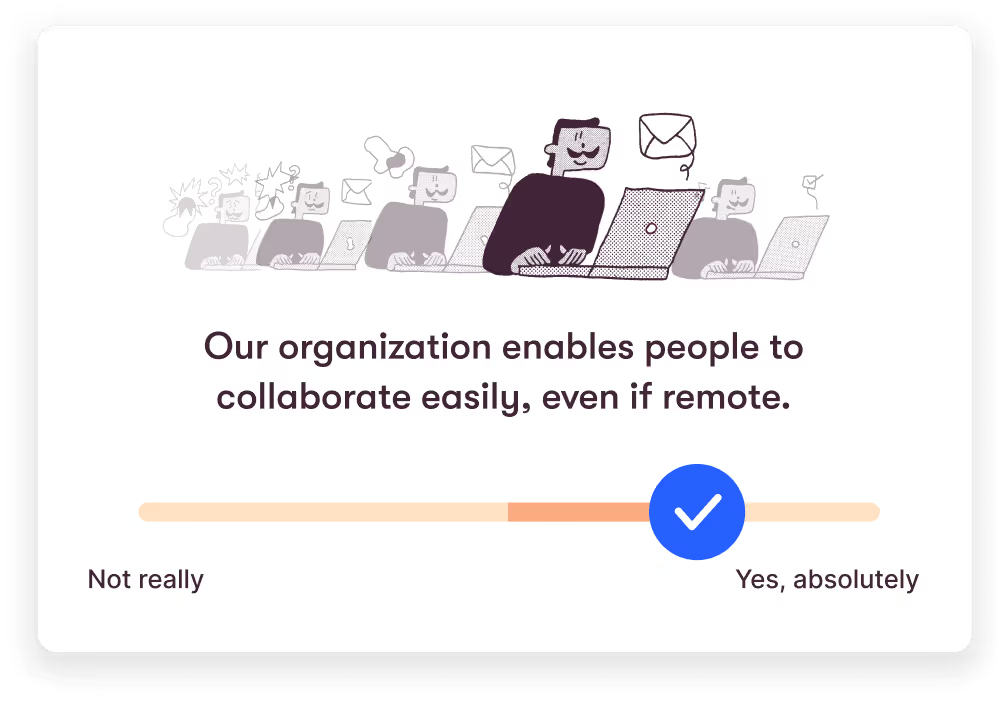Employee pulse survey best practices

Discover Workleap Officevibe's benchmark report on 12 key employee engagement metrics

If you want to tap into what drives employee satisfaction and engagement in your organization, pulse surveys can help you do exactly that. However, to use them successfully, you'll need to develop a pulse survey strategy that avoids lack of action, survey fatigue, and other common issues with employee survey initiatives.
At Officevibe, we specialize in employee surveys that help managers keep track of their team's engagement levels using intuitive reports that provide valuable insights with trend data and real-time feedback.
Read on as we dive into the best practices for pulse surveys so you can use them effectively and promote the continuous growth of your company.
What's the main purpose of a pulse survey?
Pulse surveys are quick and easy check-in surveys for getting frequent insights on employee engagement, strategic initiatives, and other workplace topics. Companies will typically send them out weekly, monthly, or quarterly to follow up on annual engagement surveys or receive instant employee feedback on changes in the organization.
Employee pulse surveys are flexible tools for getting continuous, actionable data you can use to implement changes that will benefit your employee experience. Pulse surveys let your team members know that you want to hear their thoughts and opinions more than once a year, which improves their job satisfaction and engagement.
When your employees are more engaged and happy with their work, they're more invested in helping the company succeed. Thanks to an effective pulse survey strategy, you'll see higher productivity, lower turnover, and more profitability.
Creating a pulse survey strategy for your team
While more and more companies are implementing pulse surveys in their employee listening programs, many aren't getting the most they can out of them. To get the full benefits that engagement surveys can provide, you should aim to gather meaningful insights and use them to make better decisions for your employees and help achieve your company's objectives.
Define a clear purpose
Defining your purpose involves two things:
- Asking questions about a specific topic or initiative
- Choosing the right audience
When choosing your employee survey questions and audience, you should have a specific objective in mind. Do you want to measure employee engagement? Do you want to see how employees feel about a recent change in the company?
Depending on your goal, you may only need to target a specific team or department. Selecting and narrowing down your audience helps you get relevant feedback for your strategy.
Informing your employees of the pulse survey's purpose when giving it to them increases the likelihood that they'll take part in it. Your team members will be happy to know that their employer is actively listening and planning to take action to improve their employee experience.
Ask the right questions
Once you have your purpose, think about how you will be able to use the results afterward. Based on that, you can design questions that will get you the actionable feedback you need for your strategy.
Keep in mind that pulse surveys are meant to be simple. The survey should be short and easy to complete so that you'll get a workable amount of data. Typically, pulse surveys are fewer than 15 questions.
The questions should focus on your specific topic, and the outcome should be meaningful data that you can use to create an action plan.
Set a survey frequency
A part of your strategy is deciding how often you'll send pulse surveys to your employees. Business leaders often worry that sending too many surveys will cause survey fatigue. The truth is that it's not the number of surveys that tires your employees; instead, they feel frustrated when their management doesn't take action after conducting surveys.
Share the results
You do not need to go at it alone; involving your team in the process by sharing the results of the pulse surveys will make them feel like an integral part of the organization. You can inform them of your objective and demonstrate how the results show areas that need improvement.
Together, we suggest working with your team to create a plan to achieve your goal. Accomplishing something positive with your employees based on their feedback will significantly improve company morale. It will also improve your chances of success with similar initiatives in the future.
Create an action plan
When you get the survey results back, you can start analyzing them. Look for trends and clues that point to concerns you can address, such as low employee engagement, low satisfaction with a specific topic, or negative responses to a change.
Once you've mapped out the feedback and have a clear picture of your employees' opinions, you can share the results and work on an action plan. Decide on the objective, assign tasks to your team members, and begin to implement the changes. It's best to check in regularly during this process to discuss what's working and what isn't.
Keeping your employees in the loop during this process empowers them. With this pulse survey strategy, you're giving them a voice and bringing them together to work on a goal they care about. This increase in positive engagement will help your employees feel happier with their job, increasing their job satisfaction and productivity.
What's the ideal pulse survey frequency?
The ideal survey cadence primarily depends on what's best for your organization. Every company is different, and what works for one may not work for another. How often do things fluctuate in your company? Do you work in a large organization that makes frequent adjustments that affect employee experience?
The most crucial rule of thumb in deciding the best pulse survey frequency is only to conduct surveys as often as you can take action. One of the pulse survey best practices is to create a plan for your survey. You must have an objective and use the survey results to work toward achieving that objective.
You can also use pulse surveys to check in after more in-depth annual or bi-annual company surveys. This strategy will allow you to check your employees' feelings and reactions to how your company followed up on the annual engagement survey.
With Officevibe Pulse Surveys, you can check on your employees every week with five questions that measure engagement. Our pulse survey software allows you to easily take action on employee feedback, share the results with your team, and track the progress of your changes.

Annual surveys vs. pulse surveys
Annual employee engagement surveys are generally 50-100 questions on various workplace topics that target everyone in the company. These questions usually focus on identifying what drives employee engagement in the organization and collecting data on trends that appear over time.
On the other hand, pulse surveys are short and simple. Their topic, frequency, and audience can vary to suit your needs. Rather than replacing annual surveys, you can use pulse surveys to supplement and follow up on your company-wide surveys. Pulse surveys give you continuous feedback, allowing you to keep your fingers on the pulse of your organization.
Characteristics of an annual engagement survey include:
- 50-100 questions
- company-wide scope
- a purpose to gauge employee engagement levels
- general topics
Characteristics of a pulse survey:
- 5-15 questions
- higher frequency
- specific audience and topics
- real-time feedback
Read more about the differences between pulse surveys and Annual engagement surveys.
Communicating pulse survey results to your team and creating an action plan
Sharing the results of pulse surveys with your employees will increase transparency and build trust within the organization. By promptly following up on surveys, you show your team that you value their time and opinions.
Seeing the results of their efforts will encourage them to continue giving honest feedback and can improve the data you'll receive (and relationships!) in the future.
Communicate with your employees
It's essential to communicate the purpose of pulse surveys before you launch them so your employees know what to expect and will be more inclined to take the time to share their thoughts and opinions.
These employees have a better awareness of how their work contributes to the organization and are more likely to work toward achieving the company's goals.
You can keep your employees engaged by sharing pulse survey results, your conclusions about the data, and the steps you'll take in response. It's important to give yourself enough time between surveys to communicate with your team and enact a plan. If you ask your employees to share their feelings but don't act on them, it can hurt employee engagement.
Talk about successes as well as areas for improvement
While the goal of pulse surveys is to use the data collected to make improvements, bringing up positive feedback helps you work toward a better company culture. A meeting where you only talk about where the company is falling short might not be enjoyable to sit through, but celebrating your achievements cultivates a better vibe.
While the mood is good, you can identify areas that need improvement. Explain to your employees how you came to your conclusions and why it's important to make positive changes in those areas.
For example, if your pulse survey data revealed that most employees are unsatisfied with your business's employee benefits, discuss your strategy for improving them. Involving your employees empowers them to make decisions that will help the company succeed.
Create your action plan
After gathering feedback from your employee pulse survey questions, it's time to use those actionable insights to create a plan. At this point, you should have an identified goal for improving a specific area based on the feedback from your pulse survey. You can begin working on steps toward that goal and assigning tasks to your team members.
It's essential to communicate your plan to your employees to let them know you're addressing their feedback. It sets an excellent example for future initiatives when you show your employees that you value their concerns and motivations. They'll feel more comfortable being open and honest with their feedback when they know their employer actually listens.
Check in on the plan's progress regularly
If you want to ensure that your plan succeeds, check its progress and hear how your team feels about it. After all, you're making changes based on their feedback. If they aren't happy with how the plan is going, you need to address their concerns and make adjustments.
Officevibe's Pulse Survey tool is perfect for weekly checkups. It helps you come down from your bird's eye view as a manager and get into the details of how your employees are feeling. You'll receive real-time feedback that tells you how successful your changes are, so you'll know when to back off and make modifications.
Once your plan comes to fruition, you can start another cycle of employee pulse surveys. The goal of collecting pulse survey data is to continuously improve your organization, making it a fantastic place to work. This strategy will help you keep your talented employees, increase engagement, and become more successful.
A report by Gallup found that companies with high levels of engagement are 21% more profitable, making pulse surveys a worthwhile endeavor.
Fuel employee engagement with Officevibe Pulse Surveys
Regular pulse surveys allow you to keep up with your employees' experience in the workplace and address weak points in your organization. However, following pulse survey best practices is crucial for the program to succeed.
We understand that you might struggle to fit employee surveys and action plans into your busy schedule. Fortunately, you can let Officevibe's effective Pulse Survey software do all the heavy lifting. You can focus on supporting your team, and we'll provide easy-to-read reports on engagement levels so you can quickly identify where to act.
Discover how pulse surveys can build trust in your organization and increase team effectiveness with Officevibe.
Give HR and managers the clarity, confidence, and connection to lead better every day.


%20(1).avif)


.avif)
.avif)








